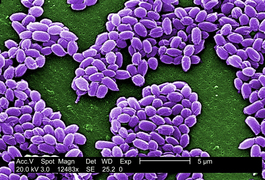 What is it?
Anthrax is a disease primarily of plant eating animals,
including: cattle, horses, mules, sheep, goats, deer, and elk. It is a naturally occurring disease in animals
around the world. Anthrax was brought to
North America by European settlers bringing animal hides, wool, and other goods
that carried anthrax spores. Cattle
drives in the 19th and early 20th centuries spread the
bacteria in Canada and the U.S.
The disease is caused by a spore-forming bacterium called
Bacillus anthracis. Ruminants are the most likely to contract it
from ingesting spores while grazing on pasture.
The spores become active in the animal’s body and the bacteria multiply,
which causes illness.
People can get the disease through contact with infected
animals or animal products.
How is it
transmitted?
Due to the longevity of the Bacillus anthracis spores in certain soils, it can survive many
years before being ingested or exposed to animals. Anthrax usually occurs in Minnesota in mid to
late summer and is primarily seen in livestock grazing on pasture. The specific pathway for exposure is not
known but grazing or browsing are potential routes of exposure. Hay or other dried feedstuffs containing
spores have also been identified as a possible route of infection.
Once inside an animal, it can transmit through blood
contact between animals and insects.
What are the signs
in animals?
In ruminants, there may be signs of high fever, muscle
tremors, difficulty breathing, and unclotted blood from any cuts or
scrapes. Many animals are found dead
before any indications of the disease, in which case the body may not stiffen
after death.
What is the
treatment?
If discovered soon enough, the disease can be treated
with antibiotic therapy. Other animals
in the herd should be moved off the pasture or away from the area to prevent
further exposure to anthrax. Before returning
to the pasture, animals should be vaccinated to protect against anthrax. Infected and exposed animals are quarantined
so there is no chance of exposed or infected animals being moved into the food
supply.
How is anthrax in
animals diagnosed?
Animals on pasture that die suddenly or are found dead
should be examined by a veterinarian to determine if anthrax is a potential
cause of death. Samples can be collected
from the carcass and submitted to a laboratory to test for anthrax.
Confirmed cases of anthrax in animals are reportable to
the Board. A follow up investigation of
these cases is done to ensure local public health and law enforcement officials
are aware of the occurrence of anthrax in livestock in the area. BAH staff work with the producer to dispose
of the carcass in a way that minimizes contamination of the environment from
anthrax and to see that other susceptible animals are removed from the area to
prevent further animal exposure to anthrax.
Is there a risk to
people?
Yes, people who handle animals with infected spores can
get a skin infection. There is also a
risk of infection by ingesting spores through consumption of an infected
animal. The greatest risk to people is
inhalation of the spores from an animal’s hide or hair. These risks are all minimal to humans.
How can it be
prevented?
Vaccination. There
is an effective vaccine for domestic animals.
It is recommended for use on animals where anthrax has been a problem
historically. The vaccine needs to be
administered annually to maintain its effectiveness.
|